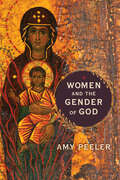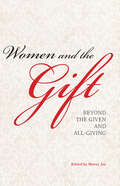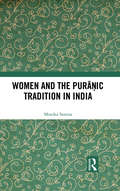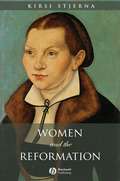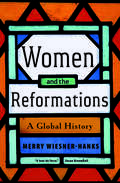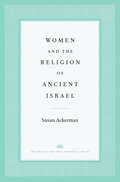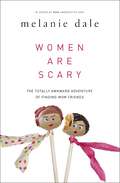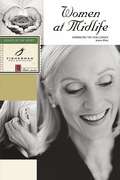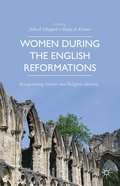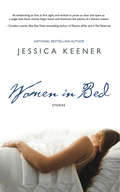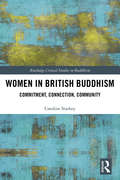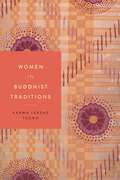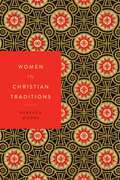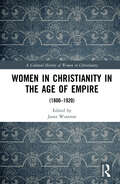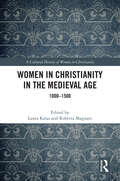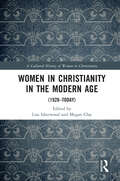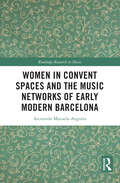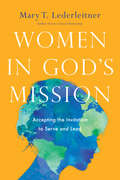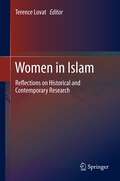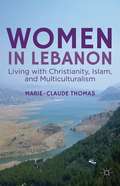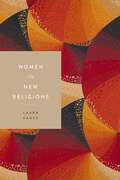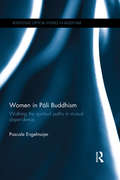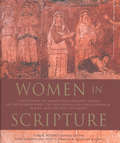- Table View
- List View
Women and the Gender of God
by Amy PeelerA robust theological argument against the assumption that God is male.God values women.While many Christians would readily affirm this truth, the widely held assumption that the Bible depicts a male God persists—as it has for centuries. This misperception of Christianity not only perniciously implies that men deserve an elevated place over women but also compromises the glory of God by making God appear to be part of creation, subject to it and its categories, rather than in transcendence of it.Through a deep reading of the incarnation narratives of the New Testament and other relevant scriptural texts, Amy Peeler shows how the Bible depicts a God beyond gender and a savior who, while embodied as a man, is the unification in one person of the image of God that resides in both male and female. Peeler begins with a study of Mary and her response to the annunciation, through which it becomes clear that God empowers women and honors their agency. Then Peeler describes from a theological standpoint how the virgin birth of Jesus—the second Adam—reverses the gendered division enacted in the garden of Eden.While acknowledging the significance of the Bible&’s frequent use of &“Father&” language to represent God as a caring parent, Peeler goes beneath the surface of this metaphor to show how God is never sexualized by biblical writers or described as being physically involved in procreation—making the concept of a masculine God dubious, at best. From these doctrinal centers of Christianity, Peeler leads the way in reasserting the value of women in the church and prophetically speaking out against the destructive idolatry of masculinity.
Women and the Gift: Beyond The Given And All-giving (Sophia Studies In Cross-cultural Philosophy Of Traditions And Cultures Ser. #17)
by Morny JoyRecent inquiries into the concept of the gift have been largely male-dominated and thus have ignored important aspects of the gift from a woman's point of view. In the light of philosophical work by Mauss, Lévi-Strauss, Derrida, and Bataille, Women and the Gift reflects how women respond to the notion of the gift and relationships of giving. This collection evaluates and critiques previous work on the gift and also responds to how women view care, fidelity, generosity, trust, and independence in light of the gift.
Women and the Puranic Tradition in India
by Monika SaxenaThis book analyses the diverse ways in which women have been represented in the Purāṇic traditions in ancient India – the virtuous wife, mother, daughter, widow, and prostitute – against the socio-religious milieu around CE 300–1000. Purāṇas (lit. ancient narratives) are brahmanical texts that largely fall under the category of socio-religious literature which were more broad-based and inclusive, unlike the Smṛtis, which were accessible mainly to the upper sections of society. In locating, identifying, and commenting on the multiplicity of the images and depictions of women’s roles in Purāṇic traditions, the author highlights their lives and experiences over time, both within and outside the traditional confines of the domestic sphere. With a focus on five Mahāpurāṇas that deal extensively with the social matrix Viṣṇu, Mārkaṇḍeya Matsya, Agni, and Bhāgavata Purāṇas, the book explores the question of gender and agency in early India and shows how such identities were recast, invented, shaped, constructed, replicated, stereotyped, and sometimes reversed through narratives. Further, it traces social consequences and contemporary relevance of such representations in marriage, adultery, ritual, devotion, worship, fasts, and pilgrimage. This volume will be of interest to researchers and scholars in women and gender studies, ancient Indian history, religion, sociology, literature, and South Asian studies, as also the informed general reader.
Women and the Reformation
by Kirsi StjernaWomen and the Reformation gathers historical materials and personal accounts to provide a comprehensive and accessible look at the status and contributions of women as leaders in the 16th century Protestant world.Explores the new and expanded role as core participants in Christian life that women experienced during the Reformation Examines diverse individual stories from women of the times, ranging from biographical sketches of the ex-nun Katharina von Bora Luther and Queen Jeanne d'Albret, to the prophetess Ursula Jost and the learned Olimpia Fulvia Morata Brings together social history and theology to provide a groundbreaking volume on the theological effects that these women had on Christian life and spirituality Accompanied by a website at www.blackwellpublishing.com/stjerna offering student's access to the writings by the women featured in the book
Women and the Reformations: A Global History
by Merry E. Wiesner-HanksA compelling, authoritative history of how women shaped the Reformations and transformed religious life across the globe The Reformations, both Protestant and Catholic, have long been told as stories of men. But women were central to the transformations that took place in Europe and beyond. What was life like for them in this turbulent period? How did their actions and ideas shape Christianity and influence societies around the world? In this rich and definitive study, renowned scholar Merry E. Wiesner-Hanks explores the history of women and the Reformations in full for the first time. Wiesner-Hanks travels the globe, examining well-known figures like Teresa of Avila, Elizabeth I, and Anne Hutchinson, as well as women whose stories are only now emerging. Along the way, we meet converts in Japan, Spanish nuns in the Philippines, and saints in Ethiopia and America. Wiesner-Hanks explores women&’s experiences as monarchs, mothers, migrants, martyrs, mystics, and missionaries, revealing that the story of the Reformations is no longer simply European—and that women played a vital role.
Women and the Religion of Ancient Israel (The Anchor Yale Bible Reference Library)
by Susan AckermanA synthetic reconstruction of women&’s religious engagement and experiences in preexilic Israel &“This monumental book examines a wealth of data from the Bible, archaeology, and ancient Near Eastern texts and iconography to provide a clear, comprehensive, and compelling analysis of women&’s religious lives in preexilic times.&”—Carol Meyers, Duke University Throughout the biblical narrative, ancient Israelite religious life is dominated by male actors. When women appear, they are often seen only on the periphery: as tangential, accidental, or passive participants. However, despite their absence from the written record, they were often deeply involved in religious practice and ritual observance. In this new volume, Susan Ackerman presents a comprehensive account of ancient Israelite women&’s religious lives and experiences. She examines the various sites of their practice, including household shrines, regional sanctuaries, and national temples; the calendar of religious rituals that women observed on a weekly, monthly, and yearly basis; and their special roles in religious settings. Drawing on texts, archaeology, and material culture, and documenting the distinctions between Israelite women&’s experiences and those of their male counterparts, Ackerman reconstructs an essential picture of women&’s lived religion in ancient Israelite culture.
Women and the Transmission of Religious Knowledge in Islam
by Asma SayeedAsma Sayeed's book explores the history of women as religious scholars from the first decades of Islam through the early Ottoman period. Focusing on women's engagement with hadīth, this book analyzes dramatic chronological patterns in women's hadīth participation in terms of developments in Muslim social, intellectual and legal history. It challenges two opposing views: that Muslim women have been historically marginalized in religious education, and alternately that they have been consistently empowered thanks to early role models such as 'Ā'isha bint Abī Bakr, the wife of the Prophet Muhammad. This book is a must-read for those interested in the history of Muslim women as well as in debates about their rights in the modern world. The intersections of this history with topics in Muslim education, the development of Sunnī orthodoxies, Islamic law and hadīth studies make this work an important contribution to Muslim social and intellectual history of the early and classical eras.
Women are Scary: The Totally Awkward Adventure of Finding Mom Friends
by Melanie DaleLet’s see…this is the part where I convince you that you need this book. This book will massage your feet. This book will bring you a fuzzy blanket at the end of a long day of parenting your tiny little insanazoids. I promise to make you snort laugh at least once. After reading this book, you’ll rock jazz hands, be able to sing on-key, and never, ever have to fold laundry again. Okay, they told me I’m actually supposed to tell you a little about the book. Um, right. Look. Here’s the thing. Too many of us women are frazzled and lonely, isolated in our minivans while schlepping bags, strollers, and munchkins to and fro across town. It doesn’t have to be this way. In this guide to “momlationships,” I use a dating analogy to take us “around the bases” to our home-run friendships, the ones that last a lifetime, not just a soccer season. This is our journey to each other, to finding our people and being other people’s people, learning how to bless each other and not destroy each other. It’s sometimes scary. And always awkward. Let’s have some fun.
Women at Midlife: Embracing the Challenges (Fisherman Bible Studyguide Series)
by Jeanie MileyMidlife is a time of transitions, some welcome and others not so welcome. Thankfully, the Bible provides principles and guidance for dealing with difficult times--midlife included. In these studies, you'll tap into that wisdom and learn how you can experience God's grace today and move forward with confidence. Whether you're struggling with the challenges of the present, mired down by mistakes in your past, or excited about the prospects of the future, you'll benefit from these important questions and life-enhancing answers for Women at Midlife.From the Trade Paperback edition.
Women during the English Reformations
by Edited by Julie A. Chappell Kaley A. KramerCatholic or Protestant, recusant or godly rebel, early modern women reinvented their spiritual and gendered spaces during the reformations in religion in England during the sixteenth century and beyond. These essays explore the ways in which some Englishwomen struggled to erase, rewrite, or reimagine their religious and gender identities.
Women in Bed
by Jessica KeenerJessica Keener's extraordinary debut novel, Night Swim captivated readers with its eloquence, insight, and humanity. "This gripping first novel announces the arrival of a strong, distinct and fully evolved new voice," said Jennifer Egan, Pulitzer Prize winner and author of A Visit from the Goon Squad. Sara Gruen, New York Times bestselling author of Water for Elephants called Keener, "An amazing new literary voice."Now Jessica Keener returns with this collection of nine stories that thematically address variations of love - love of self, family, and sexual relationships - from loneliness and isolation, desperation and rejection - to need and passion, forgiveness and, finally, to love found."Secrets" follows a young woman that gets involved with a female friend who pushes her boundaries around sex, love, and intimacy.In "Papier Mache," a college student who loses brother to suicide is grieving and gets entangled with a professor who is a critic and over-intellectualizes everything. The student challenges the professor and vice versa in a strange power dance with emotional fallout."Boarders" tells the story of a young college student who drops out to be with her narcissistic lover. She lives in grim boarding house with desolate, lonely men until she realizes that she must flee to find something better, healthier, more nurturing and loving."Woman with Birds in her Chest" involves a woman who leaves her social worker job and realizes she has never truly nurtured herself. Her ensuing breakdown puts her loving marriage to the test."Recovery" tells of a young woman in a hospital room who witnesses death, escapes her own, and comes to terms with life's uncertainties and the unexpected power of sibling love.In "Shoreline," a woman leaves her husband, goes to a cottage on the beach, and has a flirtation with a client. She soon discovers that she must end her marriage before she can move on to find a new love.In "Bird of Grief," a grad student recovering from a broken relationship projects her anger and grief onto a new man, eventually coming to terms with letting go."Forgiveness" is a spare, stark story of two sisters, family violence, and the quest for forgiveness.In "Heart," a woman meets her lover in a Paris hotel room and goes through a cycle of anxiety, worry, and the expectation that things will not work out, only to be surprised by the goodness that emerges.Poignant, surprising, funny and profound, and always perceptive and gorgeously written, Women in Bed is a rich collection of moving tales that will engage you from the first page.
Women in British Buddhism: Commitment, Connection, Community (Routledge Critical Studies in Buddhism)
by Caroline StarkeyBased on detailed ethnographic research, this book explores the varied experiences of women who have converted to Buddhism in contemporary Britain and analyses the implications of their experiences for understanding the translation and transference of Buddhist practices temporally and geographically. This book examines how women initially engage with Buddhist groups, their perspectives on religious discipline, and their relationships to ideas of gender equality and feminism. Whilst the recent study of Buddhism outside Asia has tended to emphasise the transnational and the global, this book de-centres this, highlighting the significance of locality and immediate community in contemporary women's faith practices. Showcasing the narratives and life stories of 25 ordained women across seven different Buddhist groups connected to Britain, the research in this book challenges uncritical assumptions made about 'Western' women who engage with Buddhist practices, and provides a new framing of contemporary ordination through a detailed and holistic examination of a group of Buddhist practitioners that have received little focused attention. The first multi-tradition study of ordained Buddhist women in Britain, this book will be of interest to academics working in the fields of Buddhist studies, religious studies, gender studies, Asian studies and the sociology of religion.
Women in Buddhist Traditions: Two Traditions Of Buddhist Monastic Ethics For Women - A Comparative Analysis Of The Chinese Dharmagupta And The Tibetan Mulasarvastivada Bhiksuni Pratimoksa Sutras (Women in Religions #5)
by Karma Lekshe TsomoA new history of Buddhism that highlights the insights and experiences of women from diverse communities and traditions around the worldBuddhist traditions have developed over a period of twenty-five centuries in Asia, and recent decades have seen an unprecedented spread of Buddhism globally. From India to Japan, Sri Lanka to Russia, Buddhist traditions around the world have their own rich and diverse histories, cultures, religious lives, and roles for women.Wherever Buddhism has taken root, it has interacted with indigenous cultures and existing religious traditions. These traditions have inevitably influenced the ways in which Buddhist ideas and practices have been understood and adapted. Tracing the branches and fruits of these culturally specific transmissions and adaptations is as challenging as it is fascinating.Women in Buddhist Traditions chronicles pivotal moments in the story of Buddhist women, from the beginning of Buddhist history until today. The book highlights the unique contributions of Buddhist women from a variety of backgrounds and the strategies they have developed to challenge patriarchy in the process of creating an enlightened society.Women in Buddhist Traditions offers a groundbreaking and insightful introduction to the lives of Buddhist women worldwide.
Women in Christian Traditions (Women in Religions #2)
by Rebecca MooreUncovers women's participation and impact on defining historical moments and themes of Christian traditionsWomen in Christian Traditions offers a concise and accessible examination of the roles women have played in the construction and practice of Christian traditions, revealing the enormous debt that this major world religion owes to its female followers. It recovers forgotten and obscured moments in church history to help us to realize a richer and fuller understanding of Christianity.This text provides an overview of the complete sweep of Christian history through the lens of feminist scholarship. Yet it also departs from some of the assumptions of that scholarship, raising questions that challenge our thinking about how women have shaped beliefs and practices during two thousand years of church history. Did the emphasis on virginity in the early church empower Christian women? Did the emphasis on marriage during the Reformations of the sixteenth century improve their status? These questions and others have important implications for women in Christianity in particular, and for women in religion in general, since they go to the heart of the human condition.This work examines themes, movements, and events in their historical contexts and locates churchwomen within the broader developments that have been pivotal in the evolution of Christianity. From the earliest disciples to the latest theologians, from the missionaries to the martyrs, women have been instrumental in keeping the faith alive. Women in Christian Traditions shows how they did so.
Women in Christianity in the Age of Empire: (1800–1920) (A Cultural History of Women in Christianity)
by Janet WoottonWomen in Christianity in the Age of Empire (1800–1920) offers a broad view of the nineteenth century as a time of dramatic change, particularly for women, critiqued in the light of postcolonial theory. This edited volume includes important contributions from academics in the field. Overarching themes include the cult of domesticity, the changing impact of Christianity on views of women’s nature in an age of scientific thinking, conflation of ‘gospel’ and ‘civilization’ in global mission, and the exclusion of women from public spheres of life. We meet powerful saints, campaigners, and thinkers, who bring about genuine transformation in the lives of women, and in society. But we also recognize the long shadow of Empire in the world of the twenty-first century, critiquing Colonialism and Empire, and views that restricted women’s lives. This engaging volume will be of key interest to students and scholars in Religion and Cultural Studies. Exploring the complexities of the nineteenth centur,y it draws on a range of scholarship, including TV documentaries, film, online, and more traditional academic resources.
Women in Christianity in the Medieval Age: 1000–1500 (A Cultural History of Women in Christianity)
by Laura Kalas Roberta MagnaniThis volume offers a comprehensive introduction to and investigation of the multivocality of women’s experience in the Middle Ages. In medieval Europe women saw their role in the Christian Church and society progressively confined to conflicting models of femininity epitomised by the dichotomy of Eve/Mary. Classical views of gender, predicated on misogynistic dichotomies which confined women to matter and the corruption of the flesh, were consolidated in powerful male-dominated clerical institutions and widely disseminated. Towards the end of the Middle Ages, however, women’s corporeality and somatic spirituality contributed to and influenced burgeoning modes of piety centred around the cult of the Virgin Mary and the veneration of the suffering body of Christ on the Cross. This shift in devotional practices afforded women as bodily beings the space for an increased level of self-expression, self-realisation, and authority. Ranging from philosophical and theological enquiry to education and art, as well as medical sciences and popular beliefs, the essays in this collection account for the complexities and richness of the conceptualisations and lived experiences of medieval Christian women. The book will be especially relevant to students and scholars of religion and history with an interest in medieval studies and gender. Whilst expounding the key strands of thinking in the field, it engages with and contributes to some of the latest scholarly research.
Women in Christianity in the Modern Age: (1920-today) (A Cultural History of Women in Christianity)
by Lisa IsherwoodWomen in Christianity in the Modern Age examines the role of women in Christianity in the 20th and early 21st Centuries. This edited volume includes eight important contributions from academics in the field. The modern era has been an age of social and religious upheaval, and the ravages of global warfare and changes to women’s role in society have made the examination of the place of women in religion a key question in theology. From theological concerns - engagements with the biblical texts by feminist and anti-feminist theologians, the modern role of Mary and women saints – to political and social debates on women’s ministry and place in society, and cultural shifts as expressed through theologically inspired artwork by women, Women in Christianity in the Modern Age provides an overview and in-depth studies of a tumultuous and changing era. This insightful text will be of key interest to students and scholars in Religion and Cultural Studies.
Women in Convent Spaces and the Music Networks of Early Modern Barcelona (Routledge Research in Music)
by Ascensión Mazuela-AnguitaThis book presents the first study of music in convent life in a single Hispanic city, Barcelona, during the early modern era. Exploring how convents were involved in the musical networks operating in sixteenth-century Barcelona, it challenges the invisibility of women in music history and reveals the intrinsic role played by nuns and lay women in the city’s urban musical culture. Drawing on a wide range of archival sources, this innovative study offers a cross-disciplinary approach that not only reveals details of the rich musical life in Barcelona’s nunneries, but shows how they took part in wider national and transnational networks of musical distribution, including religious, commercial, and social dimensions of music. The connections of Barcelona convents to networks for the dissemination of music in and outside the city provide a rich example of the close relationship between musical networks, urban society, and popular culture. Addressing how music was understood as a marker of identity, prestige, and social status and, above all, as a conduit between earth and heaven, this book provides new insights into how women shaped musical traditions in the urban context. It is essential reading for scholars of early modern history, musicology, history of religion, and gender studies, as well as all those with an interest in urban history and the city of Barcelona. The book is supported by additional digital appendices, which include: Records of inquiries into the lineage of Santa Maria de Jonqueres nuns Development of the collections of choir books belonging to the convents of Santa Maria de Jonqueres and Sant Antoni i Santa Clara
Women in God's Mission: Accepting the Invitation to Serve and Lead
by Mary T. LederleitnerWomen have advanced God's mission throughout history and around the world. But women often face particular obstacles in ministry. What do we need to know about how women thrive?
Women in Islam
by Terence LovatThe role of women in Islamic societies, not to mention in the religion itself, is a defining issue. It is also one that remains resistant to universal dogma, with a wide range of responses to women's social roles across the Islamic world. Reflecting this heterogeneity, the editor of this volume has assembled the latest research on the issue, which combines contemporary with historical data. The material comes from around the world as well as from Muslim and non-Muslim researchers. It takes in work from majority Muslim nations such as Bangladesh, Iran, Iraq, Lebanon, Pakistan, Palestine, Tunisia and Turkey, as well as countries with troubled interfaith relations such as India and Israel. Nations with minority Muslim populations such as France, the UK, Canada and Australia, are also represented. The work also features varying Islamic sub-groups such as the two main ones, Sunni and Shi'a, as well as less well known populations such as the Ismaili Muslims. In each case, the work is underpinned by the very latest socio-theological insights and empirical data.
Women in Islam: The Western Experience
by Anne-Sofie RoaldWomen in Islam investigates the ongoing debate across the Muslim world and the West on the position of women in Islam.Anne-Sofie Roald focuses on how Islamic perceptions of women and gender change in Western Muslim communities. She shows how Islamic attitudes towards social concerns such as gender relations, female circumcision, and female dress emerge as responsive to culture and context, rather than rigid and inflexible.
Women in Lebanon
by Marie-Claude ThomasCombining insider and outsider perspectives, Women in Lebanon looks at Christian and Muslim women living together in a multicultural society and facing modernity. While the Arab Spring has begun to draw attention to issues of change, modernity, and women's subjectivity, this manuscript takes a unique approach to examining and describing the Lebanese "alternative modernities" thesis and how it has shaped thinking about the meaning of terms like evolution, progress, development, history, and politics in contemporary Arab thought. The author draws on extensive ethnographic research, as well as her own personal experience.
Women in New Religions (Women in Religions #3)
by Laura VanceWomen in New Religions offers an engaging look at women's evolving place in the birth and development of new religious movements. It focuses on four disparate new religions--Mormonism, Seventh-day Adventism, The Family International, and Wicca--to illuminate their implications for gender socialization, religious leadership and participation, sexuality, and family ideals. Religious worldviews and gender roles interact with one another in complicated ways. This is especially true within new religions, which frequently set roles for women in ways that help the movements to define their boundaries in relation to the wider society. As new religious movements emerge, they often position themselves in opposition to dominant society and concomitantly assert alternative roles for women. But these religions are not monolithic: rather than defining gender in rigid and repressive terms, new religions sometimes offer possibilities to women that are not otherwise available. Vance traces expectations for women as the religions emerge, and transformation of possibilities and responsibilities for women as they mature. Weaving theory with examination of each movement's origins, history, and beliefs and practices, this text contextualizes and situates ideals for women in new religions. The book offers an accessible analysis of the complex factors that influence gender ideology and its evolution in new religious movements, including the movements' origins, charismatic leadership and routinization, theology and doctrine, and socio-historical contexts. It shows how religions shape definitions of women's place in a way that is informed by response to social context, group boundaries, and identity. Additional Resources
Women in Pāli Buddhism: Walking the Spiritual Paths in Mutual Dependence (Routledge Critical Studies in Buddhism)
by Pascale EngelmajerThe Pāli tradition presents a diverse and often contradictory picture of women. This book examines women’s roles as they are described in the Pāli canon and its commentaries. Taking into consideration the wider socio-religious context and drawing from early brahmanical literature and epigraphical findings, it contrasts these descriptions with the doctrinal account of women’s spiritual abilities. The book explores gender in the Pāli texts in order to delineate what it means to be a woman both in the context in which the texts were composed and in the context of their ultimate goal - that of achieving escape from the round of rebirths. The critical investigation focuses on the internal relationships and dynamics of one tradition and employs a novel methodology, which the author calls "critical sympathy". This assumes that the tradition’s teaching is valid for all, in particular that its main goal, nibbāṇa, is accessible to all human beings. By considering whether and how women’s roles fit within this path, the author examines whether women have spiritual agency not only as bhikkhunīs (Buddhist nuns), but also as wives and mothers. It offers a new understanding that focuses on how the tradition construes women’s traditional roles within an interdependent community. It aims to understand how what many scholars have seen as contradictory and inconsistent characterizations of women in Buddhism have been accepted and endorsed by the Pāli tradition. With an aim to show that the Pāli canon offers an account of women that is doctrinally coherent and consistent with its sociological facts, this book will be of interest to students and scholars of Buddhism and Asian Religion.
Women in Scripture: A Dictionary of Named and Unnamed Women in the Hebrew Bible, the Apocryphal/Deuterocanonical Books and the New Testament
by Toni Craven Carol Meyers Ross S. Kraemer&“This splendid reference describes every woman in Jewish and Christian scripture . . . monumental&” (Library Journal). In recent decades, many biblical scholars have studied the holy text with a new focus on gender. Women in Scripture is a groundbreaking work that provides Jews, Christians, or anyone fascinated by a body of literature that has exerted a singular influence on Western civilization a thorough look at every woman and group of women mentioned in the Bible, whether named or unnamed, well known or heretofore not known at all. They are remarkably varied—from prophets to prostitutes, military heroines to musicians, deacons to dancers, widows to wet nurses, rulers to slaves. There are familiar faces, such as Eve, Judith, and Mary, seen anew with the full benefit of the most up-to-date results of biblical scholarship. But the most innovative aspect of this book is the section devoted to the many females who in the scriptures do not even have names. Combining rigorous research with engaging prose, these articles on women in the Hebrew Bible, the Apocryphal/Deuterocanonical Books, and the New Testament will inform, delight, and challenge readers interested in the Bible, scholars and laypeople alike. Together, these collected histories create a volume that takes the study of women in the Bible to a new level.
